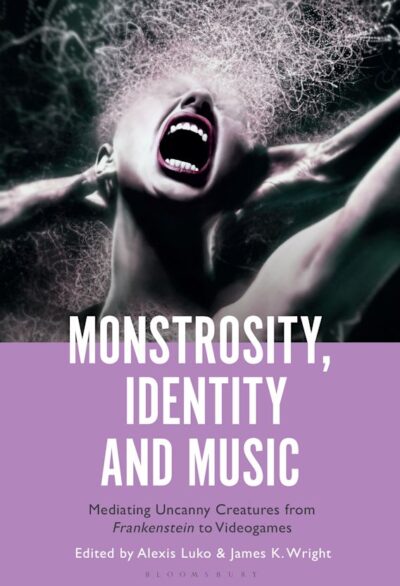Screams, Shrieks and Shudders
New book from Carleton musicologist explores monsters in classic and popular art, literature and media
By Alyssa Tremblay
What can stories about vampires, sirens and reanimated corpses tell us about what it means to be human?
This is the central question haunting Monstrosity, Identity, and Music: Mediating Uncanny Creatures from Frankenstein to Videogames, a new book from Dr. James Wright, Professor of Music in the School for Studies in Arts and Culture and the College of the Humanities.

Co-edited alongside former Carleton faculty member Dr. Alexis Luko (Director of the School of Music at the University of Victoria), the book features – appropriately enough for triskaidekaphobics, given its ominous subject matter! – thirteen chapters examining depictions of monsters in film, theatre, comics, music, art, and video games, including an article by another Carleton colleague, Dr. John Higney.
A musicologist, Wright is no stranger to the topic of unsettling sounds.
His own chapter in the book, titled “Twelve-Tone Terror: Representing Horror and Monstrosity in Dodecaphonic Film Music”, explores the popularity of Austrian composer Arnold Schoenberg’s unsettlingly dissonant and atonal twelve-tone compositional method in horror film scores.

“This music tends to invoke feelings of terror, angst, madness, foreboding, the surreal, and recoil from monstrosity, and when these moods have been called for by the film’s plot, character development, or mise en scène, many film composers have turned to these compositional techniques,” says Wright.
This book is the latest, but not the first, horror-themed addition to Wright’s academic oeuvre.
Around Halloween in 2019, he co-chaired an interdisciplinary conference at the Carleton Dominion-Chalmers Centre celebrating the bicentenary of Mary Shelley’s Frankenstein.
“Having grown up with a more or less comic book conception of Frankenstein, when I first read Frankenstein at the age of twenty, I was surprised but inspired to discover that this was truly classic gothic literature.”
According to Wright, the fictional story of Dr. Victor Frankenstein and his creature poses “profound, troubling, and important questions about the human condition, science, technology, religion, ethics, and human destiny.”
But (to quote from the book’s introduction) why should we study “abject creatures torn from the deepest and darkest imaginings of the human psyche”?
How can the gothic and the grotesque help us rethink performance and creative expression, given how so much of the language used to describe artistic endeavors revolves around beauty?
“So much important twentieth- and twenty-first-century art seeks to trouble and undermine former conceptions of beauty in art, and of the importance of art in our lives and cultures,” explains Wright.
“Rather than taking up arms, we pick up our brushes, pens, cameras, clay, and musical instruments, to resist and wrestle with the horrors, injustices and alienation of modernity. Art that deals with monstrosity often tackles these issues head on.”
In film, for example, Wright describes how confrontation with the monstrous can both strike terror into our hearts (think Swiss artist Hans Giger’s surreal biomechanical space creature in Ridley Scott’s 1979 film Alien) and lift up important themes like Othering, xenophobia, difference, misguided science run amok, disability, the folly of war, and the tragic destructiveness of superficial notions of human beauty.
Speaking of film, and in the spirit of spooky season, Wright offers three suggestions for anyone looking for some spine-tinglingly scored horror films to watch:
“One of my favorite classic horror film scores is Jerry Goldsmith’s brilliant music for Franklin J. Schaffner’s Planet of the Apes (1968), starring Charlton Heston. Never before or since has a film composer employed twelve-tone atonal technique so thoroughly as Goldsmith did in this austere score. The score brilliantly casts an eerie ‘anempathetic’ pall over the entire film, a chilling and detached musical indifference to the violence and human tragedy that is happening on-screen.”
“Among the scores written for horror and thriller films from Hollywood’s “golden era,” Bernard Hermann’s music for Hitchcock’s Vertigo (1959) is the stand-out masterpiece for me. The film focuses on themes of obsession, distorted reality, love and death, and Hermann’s timeless score captures and conveys these moods perfectly (in Jimmy Stewart’s unforgettable kiss scene with Kim Novak, and in the nightmare scene in particular). Hermann’s music for the shower scene in Psycho might be better known, but for me Vertigo is his pinnacle achievement.”
“More recently I was also overwhelmed by a brilliant horror film score by the young Icelandic composer Hildur Ingveldardóttir Guðnadóttir, precisely because it completely chilled me to the bone! Her Oscar-winning music for Todd Phillips’ psychological thriller Joker (2019) combines creepy orchestral textures for conventional instruments, moaning and guttural low-frequency electroacoustic sounds, and improvisation on the composer’s halldorophone (electroacoustic cello) with periodic feedback, all of which provide a disturbingly bleak musical backdrop for the murderous rampages of the psychopathic lead character, played by Joaquin Phoenix. Guðnadóttir’s horrifying Joker score shows the way forward with exciting new techniques and soundscapes, and for me this is as good as it gets.”